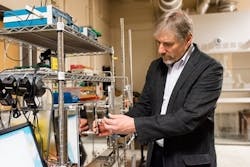What the Largest IAQ Experiment Shows About Your Indoor Air
The average American lives to be 79 years old – and 70 of those years are spent inside buildings. As a result, most of the air pollution we breathe during our lifetime, we breathe indoors. That means it’s crucial to make sure you’re monitoring your building’s indoor air quality. And an unprecedented experiment from the University of Texas-Austin could help guide you.
Throughout June 2018, researchers from 13 universities worked together to conduct a month-long IAQ experiment at UT-Austin’s UTest House facility. The goal was to understand how indoor chemical compounds interact and change throughout our daily lives.
“There wasn’t a lot of overlap. There were researchers using very high-powered instrumentation but not a lot of the same instrumentation. We wanted to cover as many pollutants as possible,” he continues.
The Indoor Air Quality Experiment
Created about 12 years ago, the UTest House is a 1,200-square-foot home with three bedrooms, two bathrooms, a fully equipped kitchen and a living room.
“The focus of this project is really to better understand the chemistry [of indoor air quality] and some of the major factors that affect it,” Corsi says.
To that end, researchers focused on two activities – cooking and cleaning – and rotationally simulated both throughout the month-long experiment. Cleaning involved using chlorine-based products vs. turpentine products, while cooking involved stovetop cooking vs. oven cooking.
Researchers even staged a Thanksgiving dinner with about a dozen “guests” in attendance at the UTest House as a way to assess the impact of human occupation on indoor air quality and surface chemistry.
The Initial Findings
In the cleaning aspect of the experiment, for instance, Hildebrandt Ruiz says they focused on the use of chlorinated products, such as bleach, and turpentine products, which are typically pine- or citrus-scented.
“Turpentine products are not naturally dangerous, but when they are oxidized in indoor or outdoor environments – with, for example, ozone – they can form particulates,” Hildebrandt Ruiz says. “You can start getting byproducts, some of which can be harmful to human health.”
Corsi agrees that indoor air, especially in buildings, is complicated. “An air shed in Philadelphia or Washington, D.C. or Los Angeles, that outdoor air pollution affects everybody,” he says. “You essentially have one atmosphere that everybody’s submerged in, whereas every building is like its own atmosphere. Every building is different – the chemistry’s different.”
What to Consider About the Air Indoors
Although much of the data is still being analyzed, this initial phase of the experiment presents some things to keep in mind when monitoring the indoor air quality of your building or facility. One thing, Corsi explains, is that the U.S. lacks regulatory drivers for indoor air quality.
“What other countries have done is to regulate the products that come into buildings: building materials that can be used or consumer products that can be used,” Corsi says. “Our country hasn’t gotten there yet. The state of California has moved in that direction a little bit.”
Because there aren’t many regulations, Corsi says as a result, there’s not much funding for research – which further solidifies the important of the UTest House experiment.
Adds Corsi, “We regulate the heck out of outdoor pollution, but we breathe most of it indoors. From my standpoint, I’ve always felt that’s exciting because that means we could design buildings differently to really dramatically reduce our exposure to air pollution.”
“There’s not a lot known about the chemical reactions that occur in indoor environments,” Hildebrandt Ruiz explains. “The goal of this initial project was really to understand what kind of chemistry we can expect when we cook and clean – what kinds of things are emitted and how do they transform in the environment? It was more scientific than it was practical. But it is the first step to then be able to say, ‘Now what can we do to reduce the concentration?’”
Two hand-picked articles to read next:
About the Author

Sarah Kloepple
Associate Editor
Sarah joined the BUILDINGS team as an associate editor in August 2018. She is a graduate of the Missouri School of Journalism, where her focus was magazine writing. She's written and edited for numerous publications in her hometown of St. Louis.
